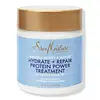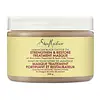What's inside
What's inside
 Key Ingredients
Key Ingredients

 Benefits
Benefits

 Concerns
Concerns

 Ingredients Side-by-side
Ingredients Side-by-side

Water
Skin ConditioningBehentrimonium Chloride
PreservativeCaprylic/Capric Triglyceride
MaskingHydrogenated Castor Oil
EmollientCetearyl Alcohol
EmollientButyrospermum Parkii Butter
Skin ConditioningStearyl Alcohol
EmollientGlycerin
HumectantHoney
HumectantButyrospermum Parkii Oil
EmollientYogurt Powder
Yogurt Extract
Skin ConditioningCocos Nucifera Oil
MaskingSimmondsia Chinensis Butter
Skin ConditioningHydrogenated Jojoba Oil
AbrasiveAdansonia Digitata Seed Oil
EmollientTrichilia Emetica Seed Oil PEG-8 Esters
EmollientAllantoin
Skin ConditioningPanthenol
Skin ConditioningHydrolyzed Vegetable Protein Pg-Propyl Silanetriol
Skin ConditioningTocopherol
AntioxidantTriethyl Citrate
MaskingCaprylyl Glycol
EmollientInulin
Skin ConditioningBenzoic Acid
MaskingParfum
MaskingWater, Behentrimonium Chloride, Caprylic/Capric Triglyceride, Hydrogenated Castor Oil, Cetearyl Alcohol, Butyrospermum Parkii Butter, Stearyl Alcohol, Glycerin, Honey, Butyrospermum Parkii Oil, Yogurt Powder, Yogurt Extract, Cocos Nucifera Oil, Simmondsia Chinensis Butter, Hydrogenated Jojoba Oil, Adansonia Digitata Seed Oil, Trichilia Emetica Seed Oil PEG-8 Esters, Allantoin, Panthenol, Hydrolyzed Vegetable Protein Pg-Propyl Silanetriol, Tocopherol, Triethyl Citrate, Caprylyl Glycol, Inulin, Benzoic Acid, Parfum
Water
Skin ConditioningCetearyl Alcohol
EmollientCocos Nucifera Oil
MaskingGlycerin
HumectantButyrospermum Parkii Butter
Skin ConditioningStearyl Alcohol
EmollientCetyl Alcohol
EmollientBehentrimonium Methosulfate
Parfum
MaskingBehentrimonium Chloride
PreservativePanthenol
Skin ConditioningHydrolyzed Wheat Protein
Skin ConditioningHydrolyzed Wheat Starch
Skin ConditioningCetrimonium Chloride
AntimicrobialPersea Gratissima Oil
Skin ConditioningMangifera Indica Seed Butter
Skin ConditioningOlea Europaea Fruit Oil
MaskingRicinus Communis Seed Oil
MaskingMentha Piperita Leaf Extract
Skin ConditioningMauritia Flexuosa Fruit Oil
Skin ConditioningYeast Extract
Skin ConditioningHydrolyzed Keratin
HumectantMacadamia Ternifolia Seed Oil
EmollientTocopherol
AntioxidantNiacin
SmoothingAloe Barbadensis Leaf Juice
Skin ConditioningAcetic Acid
BufferingHydrogenated Vegetable Oil
EmollientGlycine Soja Oil
EmollientTrifolium Pratense Flower Extract
AstringentCaramel
Cosmetic ColorantPropanediol
SolventCaprylhydroxamic Acid
Caprylyl Glycol
EmollientBenzoic Acid
MaskingWater, Cetearyl Alcohol, Cocos Nucifera Oil, Glycerin, Butyrospermum Parkii Butter, Stearyl Alcohol, Cetyl Alcohol, Behentrimonium Methosulfate, Parfum, Behentrimonium Chloride, Panthenol, Hydrolyzed Wheat Protein, Hydrolyzed Wheat Starch, Cetrimonium Chloride, Persea Gratissima Oil, Mangifera Indica Seed Butter, Olea Europaea Fruit Oil, Ricinus Communis Seed Oil, Mentha Piperita Leaf Extract, Mauritia Flexuosa Fruit Oil, Yeast Extract, Hydrolyzed Keratin, Macadamia Ternifolia Seed Oil, Tocopherol, Niacin, Aloe Barbadensis Leaf Juice, Acetic Acid, Hydrogenated Vegetable Oil, Glycine Soja Oil, Trifolium Pratense Flower Extract, Caramel, Propanediol, Caprylhydroxamic Acid, Caprylyl Glycol, Benzoic Acid
Ingredients Explained
These ingredients are found in both products.
Ingredients higher up in an ingredient list are typically present in a larger amount.
This ingredient is a preservative and often used for it's anti-static properties. You'll most likely see this ingredient in hair conditioners.
It does not cause irritation or sensitization in leave-on products at 1-5%.
Benzoic Acid is used to preserve and adjust the pH of products.
The antimicrobial property of Benzoic Acid helps elongate a product's shelf life. Its main role is to reduce fungi growth and is not found to be effective at fighting bacteria. Therefore Benzoic Acid is always added along with other preservatives.
In its pure form, Benzoic Acid looks like a white crystalline solid. It has slight solubility in water.
The name of Benzoic Acid comes from gum benzoin, which used to be the sole source of deriving this ingredient. Benzoic Acid is the most simple aromatic carboxylic acid.
Benzoic Acid is naturally occuring in strawberries, mustard, cinnamon, and cloves. It has a slight scent but is not considered to be a fragrance.
Learn more about Benzoic AcidThis ingredient is also known as shea butter. It is an effective skin hydrator and emollient.
Emollients help soothe and soften your skin. It does this by creating a protective film on your skin. This barrier helps trap moisture and keeps your skin hydrated. Emollients may be effective at treating dry or itchy skin.
Shea butter is rich in antioxidants. Antioxidants help fight free-radicals, or molecules that may harm the body. It is also full of fatty acids including stearic acid and linoleic acid. These acids help replenish the skin and keep skin moisturized.
While Shea Butter has an SPF rating of about 3-4, it is not a sunscreen replacement.
Shea butter may not be fungal acne safe. We recommend speaking with a professional if you have any concerns.
Learn more about Butyrospermum Parkii ButterCaprylyl Glycol is a humectant and emollient, meaning it attracts and preserves moisture.
It is a common ingredient in many products, especially those designed to hydrate skin. The primary benefits are retaining moisture, skin softening, and promoting a healthy skin barrier.
Though Caprylyl Glycol is an alcohol derived from fatty acids, it is not the kind that can dry out skin.
This ingredient is also used as a preservative to extend the life of products. It has slight antimicrobial properties.
Learn more about Caprylyl GlycolCetearyl alcohol is a mixture of two fatty alcohols: cetyl alcohol and stearyl alcohol. It is mainly used as an emulsifier. Emulsifiers help prevent the separation of oils and products. Due to its composition, it can also be used to thicken a product or help create foam.
Cetearyl alcohol is an emollient. Emollients help soothe and hydrate the skin by trapping moisture.
Studies show Cetearyl alcohol is non-toxic and non-irritating. The FDA allows products labeled "alcohol-free" to have fatty alcohols.
This ingredient is usually derived from plant oils such as palm, vegetable, or coconut oils. There is debate on whether this ingredient will cause acne.
Due to the fatty acid base, this ingredient may not be Malassezia folliculitis safe.
Learn more about Cetearyl AlcoholCocos Nucifera Oil is obtained from the kernels of the coconut fruit. In other words, this is coconut oil.
Coconut Oil is rich in fatty acids with lauric acid making up the majority of these. It also contains linoleic acid. Due to this high fatty acid content, coconut oil helps trap moisture and soften skin.
Despite being antibacterial, coconut oil may not be great for acne-prone skin. It is comedogenic and may clog pores. This ingredient may not be safe for malassezia or fungal acne.
Note: Coconut Oil should not replace your sunscreen for UV protection. Studies show it only blocks about 20% of UV.
This oil is non-volatile and has a light scent.
The term 'fragrance' is not regulated in many countries. In many cases, it is up to the brand to define this term. For instance, many brands choose to label themselves as "fragrance-free" because they are not using synthetic fragrances. However, their products may still contain ingredients such as essential oils that are considered a fragrance.
Learn more about Cocos Nucifera OilGlycerin is already naturally found in your skin. It helps moisturize and protect your skin.
A study from 2016 found glycerin to be more effective as a humectant than AHAs and hyaluronic acid.
As a humectant, it helps the skin stay hydrated by pulling moisture to your skin. The low molecular weight of glycerin allows it to pull moisture into the deeper layers of your skin.
Hydrated skin improves your skin barrier; Your skin barrier helps protect against irritants and bacteria.
Glycerin has also been found to have antimicrobial and antiviral properties. Due to these properties, glycerin is often used in wound and burn treatments.
In cosmetics, glycerin is usually derived from plants such as soybean or palm. However, it can also be sourced from animals, such as tallow or animal fat.
This ingredient is organic, colorless, odorless, and non-toxic.
Glycerin is the name for this ingredient in American English. British English uses Glycerol/Glycerine.
Learn more about GlycerinPanthenol is a common ingredient that helps hydrate and soothe the skin. It is found naturally in our skin and hair.
There are two forms of panthenol: D and L.
D-panthenol is also known as dexpanthenol. Most cosmetics use dexpanthenol or a mixture of D and L-panthenol.
Panthenol is famous due to its ability to go deeper into the skin's layers. Using this ingredient has numerous pros (and no cons):
Like hyaluronic acid, panthenol is a humectant. Humectants are able to bind and hold large amounts of water to keep skin hydrated.
This ingredient works well for wound healing. It works by increasing tissue in the wound and helps close open wounds.
Once oxidized, panthenol converts to pantothenic acid. Panthothenic acid is found in all living cells.
This ingredient is also referred to as pro-vitamin B5.
Learn more about PanthenolParfum is a catch-all term for an ingredient or more that is used to give a scent to products.
Also called "fragrance", this ingredient can be a blend of hundreds of chemicals or plant oils. This means every product with "fragrance" or "parfum" in the ingredients list is a different mixture.
For instance, Habanolide is a proprietary trade name for a specific aroma chemical. When used as a fragrance ingredient in cosmetics, most aroma chemicals fall under the broad labeling category of “FRAGRANCE” or “PARFUM” according to EU and US regulations.
The term 'parfum' or 'fragrance' is not regulated in many countries. In many cases, it is up to the brand to define this term.
For instance, many brands choose to label themselves as "fragrance-free" because they are not using synthetic fragrances. However, their products may still contain ingredients such as essential oils that are considered a fragrance by INCI standards.
One example is Calendula flower extract. Calendula is an essential oil that still imparts a scent or 'fragrance'.
Depending on the blend, the ingredients in the mixture can cause allergies and sensitivities on the skin. Some ingredients that are known EU allergens include linalool and citronellol.
Parfum can also be used to mask or cover an unpleasant scent.
The bottom line is: not all fragrances/parfum/ingredients are created equally. If you are worried about fragrances, we recommend taking a closer look at an ingredient. And of course, we always recommend speaking with a professional.
Learn more about ParfumStearyl Alcohol is a type of fatty alcohol from stearic acid. It is a white, waxy compound used to emulsify ingredients.
Fatty Alcohols are most often used as an emollient or to thicken a product. Emollients help soothe and hydrate the skin by trapping moisture.
They are usually derived from natural fats and oils and therefore do not have the same drying or irritating effect as solvent alcohols. FDA allows products labeled "alcohol-free" to have fatty alcohols.
Learn more about Stearyl AlcoholTocopherol (also known as Vitamin E) is a common antioxidant used to help protect the skin from free-radicals and strengthen the skin barrier. It's also fat soluble - this means our skin is great at absorbing it.
Vitamin E also helps keep your natural skin lipids healthy. Your lipid skin barrier naturally consists of lipids, ceramides, and fatty acids. Vitamin E offers extra protection for your skin’s lipid barrier, keeping your skin healthy and nourished.
Another benefit is a bit of UV protection. Vitamin E helps reduce the damage caused by UVB rays. (It should not replace your sunscreen). Combining it with Vitamin C can decrease sunburned cells and hyperpigmentation after UV exposure.
You might have noticed Vitamin E + C often paired together. This is because it is great at stabilizing Vitamin C. Using the two together helps increase the effectiveness of both ingredients.
There are often claims that Vitamin E can reduce/prevent scarring, but these claims haven't been confirmed by scientific research.
Learn more about TocopherolWater. It's the most common cosmetic ingredient of all. You'll usually see it at the top of ingredient lists, meaning that it makes up the largest part of the product.
So why is it so popular? Water most often acts as a solvent - this means that it helps dissolve other ingredients into the formulation.
You'll also recognize water as that liquid we all need to stay alive. If you see this, drink a glass of water. Stay hydrated!
Learn more about Water